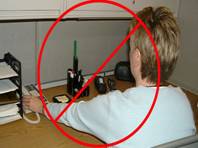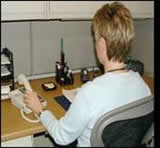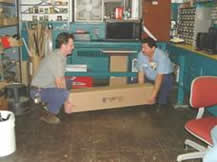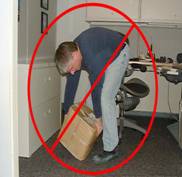Change Postures Frequently
Muscle strain and tension can build up when you remain in the same position for long periods of time. Taking mini-breaks can help to relax muscles. A break from your work to rest, stretch, or move around for two or three minutes every 20 to 30 minutes can make a big difference in reducing fatigue, stiffness and discomfort. Find another position to work in such as changing your chair height or seat angle, standing rather than sitting, or repositioning your armrests. It doesn’t really matter as long as you change positions throughout the day! This not only allows muscles to recover, but keeps blood circulating and provides oxygen to muscle tissues.
Organize Your Workstation
How you organize your workstation supplies, tools and equipment determines how you use your body. For example, when you have to reach overhead for a manual or across the desk for the phone or the mouse, or when you are too far away from the monitor to see clearly, the action of leaning forward, reaching, bending the wrists or neck and squinting to see your work can contribute to physical strain if you do it over and over throughout the day.
Alternate Job Tasks
When you perform the same tasks over and over, it places increasing strain on the muscles and tendons that are doing the work. To reduce the risk of strain that may result from repetitive work, it is important to alternate the tasks that you do. This will allow certain muscle groups to rest while other muscle groups are working. For example, if you spend a lot of time typing on the keyboard, break up this repetitive pattern by making necessary phone calls, copying documents or delivering a package.
Avoid Eyestrain
Eyestrain is a common problem in the workplace. If you perform visually demanding tasks such as use of a microscope or a computer, your eyes may become dry, irritated or strained. If you experience eyestrain, see your eye care specialist. A new optical prescription or special computer glasses may be helpful in reducing eyestrain. For computer work, the position, distance, and height of the monitor is important. Glare on the screen and light that is too bright or too dim can contribute to eyestrain. Resting your eyes throughout the day and practicing eye exercises can make a difference. One helpful exercise is to look far up to the right corner of the eye, look down to the left, look up to the left corner, then down to the right. This will work most muscles of the eye. Change focal distance by looking away from close-up work to as far away as you can see (e.g. across the parking lot, down the hallway, out the window). Blink often to keep the eyes lubricated.
Protect Your Back!
Lifting incorrectly can put you at risk for back injury. Be alert when you need to lift something. Plan how you will lift before you begin. Keep your body properly aligned when lifting and moving heavy or bulky objects. Bring the object close to you. Pick up the object by bending your knees and keeping your back in its natural “S” curve, then lift and carry it. If you have to move the object a long distance, use wheels, a cart, a hand truck or request help from another person.
Bending and twisting while lifting heavy items can be dangerous. Bending forward and reaching for something such as files, the phone, a manual or objects you need to work with places a lot of strain on your back and may contribute to back strain, even if the object weighs very little. Move closer to the object and turn your whole body rather than twist.














